The Protective Effects of Silkworm (Bombyx mori) Pupae Peptides on UV-Induced Skin Photoaging in Mice
Abstract
1. Introduction
2. Materials and Methods
2.1. Materials
2.2. Extraction and Preparation of SPPs from Silkworm Pupae Protein
2.3. Tyrosinase Inhibitory Activity Assay
2.4. Peptide Sequence Analysis
2.5. Animal Experiments
2.6. Macroscopic Examination of Mice Dorsal Skins
2.7. Histological Analysis
2.8. ROS, MDA Levels, and Antioxidant Enzyme Activities
2.9. Analysis of Levels of Inflammatory Markers and MMPs
2.10. Statistical Analysis
3. Results and Discussion
3.1. Molecular Weight and Peptide Composition of SPPs
3.2. Macroscopic Visual Appearance in Photoaging Skin
3.3. Visual Scores, Skin Elasticity, and Thickness
3.4. Histological Evaluation of Skin Tissue
3.5. Effect of SPPs on the Thymus and Spleen Index
3.6. ROS, MDA Levels, and Antioxidant Enzyme Activities
3.7. Analysis of Levels of Inflammatory Cytokines
3.8. Biomarkers Related to Collagen Stability and Degradation
4. Conclusions
Supplementary Materials
Author Contributions
Funding
Institutional Review Board Statement
Informed Consent Statement
Data Availability Statement
Acknowledgments
Conflicts of Interest
References
- Wu, X.; He, K.; Velickovic, T.C.; Liu, Z. Nutritional, Functional, and Allergenic Properties of Silkworm Pupae. Food Sci. Nutr. 2021, 9, 4655–4665. [Google Scholar] [CrossRef] [PubMed]
- Zhou, Y.; Zhou, S.; Duan, H.; Wang, J.; Yan, W. Silkworm Pupae: A Functional Food with Health Benefits for Humans. Foods 2022, 11, 1594–1614. [Google Scholar] [CrossRef] [PubMed]
- Wu, X.; Yang, J.; Mumby, W.; Zhang, Y.; Zhang, Y.; Wang, C.; Chen, X.; Suo, H.; Song, J. Silkworm Pupa Protein and Its Peptides: Preparation, Biological Activity, Applications in Foods, and Advantages. Trends Food Sci. Technol. 2023, 139, 104129. [Google Scholar] [CrossRef]
- Lin, X.; Wang, F.; Lu, Y.; Wang, J.; Chen, J.; Yu, Y.; Tao, X.; Xiao, Y.; Peng, Y. A Review on Edible Insects in China: Nutritional Supply, Environmental Benefits, and Potential Applications. Curr. Res. Food Sci. 2023, 7, 100596. [Google Scholar] [CrossRef] [PubMed]
- Kozlu, A.; Ngasakul, N.; Klojdová, I.; Baigts-Allende, D.K. Edible Insect-Processing Techniques: A Strategy to Develop Nutritional Food Products and Novelty Food Analogs. Eur. Food Res. Technol. 2024, 250, 1253–1267. [Google Scholar] [CrossRef]
- Attaribo, T.; Jiang, X.; Huang, G.; Zhang, B.; Xin, X.; Zhang, Y.; Zhang, N.; Gui, Z. Studies on the Interactional Characterization of Preheated Silkworm Pupae Protein (SPP) with Anthocyanins (C3G) and Their Effect on Anthocyanin Stability. Food Chem. 2020, 326, 126904. [Google Scholar] [CrossRef] [PubMed]
- Herman, R.A.; Yan, C.-H.; Wang, J.Z.; Xun, X.M.; Wu, C.K.; Li, Z.N.; Ayepa, E.; You, S.; Gong, L.C.; Wang, J. Insight into the Silkworm Pupae: Modification Technologies and Functionality of the Protein and Lipids. Trends Food Sci. Technol. 2022, 129, 408–420. [Google Scholar] [CrossRef]
- Zhang, Y.; Wang, J.; Zhu, Z.; Li, X.; Sun, S.; Wang, W.; Sadiq, F.A. Identification and Characterization of Two Novel Antioxidant Peptides from Silkworm Pupae Protein Hydrolysates. Eur. Food Res. Technol. 2021, 247, 343–352. [Google Scholar] [CrossRef]
- Li, Z.; Zhao, S.; Xin, X.; Zhang, B.; Thomas, A.; Charles, A.; Lee, K.S.; Jin, B.R.; Gui, Z. Purification, Identification and Functional Analysis of a Novel Immunomodulatory Peptide from Silkworm Pupa Protein. Int. J. Pept. Res. Ther. 2020, 26, 243–249. [Google Scholar] [CrossRef]
- Zhou, Y.; Ji, X.; Wang, D.; Guo, Y.; Zhao, J.; Yan, W. Effect of Silkworm Pupae (Bombyx mori) Protein on Colon Cancer in Nude Mice: Inhibition of Tumor Growth, Oxidative Stress and Inflammatory Response. Front. Pharmacol. 2023, 14, 1138742. [Google Scholar] [CrossRef]
- Cermeño, M.; Bascón, C.; Amigo-Benavent, M.; Felix, M.; FitzGerald, R.J. Identification of Peptides from Edible Silkworm Pupae (Bombyx mori) Protein Hydrolysates with Antioxidant Activity. J. Funct. Foods 2022, 92, 105052. [Google Scholar] [CrossRef]
- Luo, F.; Fu, Y.; Ma, L.; Dai, H.; Wang, H.; Chen, H.; Zhu, H.; Yu, Y.; Hou, Y.; Zhang, Y. Exploration of Dipeptidyl Peptidase-IV (DPP-IV) Inhibitory Peptides from Silkworm Pupae (Bombyx mori) Proteins Based on In Silico and In Vitro Assessments. J. Agric. Food Chem. 2022, 70, 3862–3871. [Google Scholar] [CrossRef] [PubMed]
- Ho, T.-Y.; Lo, H.-Y.; Lu, G.-L.; Lin, C.-Y.; Stevens, M.-L.; Chen, C.-C.; Hsiang, C.-Y. Screening and Rational Identification of a Novel Angiotensin-Converting Enzyme C-Domain Inhibitory Peptide from Fabaceae Food Peptide Library. Food Chem. 2024, 452, 139540. [Google Scholar] [CrossRef] [PubMed]
- Lee, S.H.; Park, D.; Yang, G.; Bae, D.K.; Yang, Y.H.; Kim, T.K.; Kim, D.; Kyung, J.; Yeon, S.; Koo, K.C.; et al. Silk and Silkworm Pupa Peptides Suppress Adipogenesis in Preadipocytes and Fat Accumulation in Rats Fed a High-Fat Diet. Eur. J. Nutr. 2012, 51, 1011–1019. [Google Scholar] [CrossRef]
- Guan, L.L.; Lim, H.W.; Mohammad, T.F. Sunscreens and Photoaging: A Review of Current Literature. Am. J. Clin. Dermatol. 2021, 22, 819–828. [Google Scholar] [CrossRef] [PubMed]
- Wang, J.; Qiu, H.; Xu, Y.; Gao, Y.; Tan, P.; Zhao, R.; Liu, Z.; Tang, Y.; Zhu, X.; Bao, C.; et al. The Biological Effect of Recombinant Humanized Collagen on Damaged Skin Induced by UV-Photoaging: An In Vivo Study. Bioact. Mater. 2022, 11, 154–165. [Google Scholar] [CrossRef]
- Geng, R.; Kang, S.G.; Huang, K.; Tong, T. Boosting the Photoaged Skin: The Potential Role of Dietary Components. Nutrients 2021, 13, 1691–1717. [Google Scholar] [CrossRef]
- Liu, Z.; Li, Y.; Song, H.; He, J.; Li, G.; Zheng, Y.; Li, B. Collagen Peptides Promote Photoaging Skin Cell Repair by Activating the TGF-β/Smad Pathway and Depressing Collagen Degradation. Food Funct. 2019, 10, 6121–6134. [Google Scholar] [CrossRef] [PubMed]
- Zhang, X.; Zhuang, H.; Wu, S.; Mao, C.; Dai, Y.; Yan, H. Marine Bioactive Peptides: Anti-Photoaging Mechanisms and Potential Skin Protective Effects. Curr. Issues Mol. Biol. 2024, 46, 990–1009. [Google Scholar] [CrossRef]
- Saad, M.; El-Samad, L.M.; Gomaa, R.A.; Augustyniak, M.; Hassan, M.A. A Comprehensive Review of Recent Advances in Silk Sericin: Extraction Approaches, Structure, Biochemical Characterization, and Biomedical Applications. Int. J. Biol. Macromol. 2023, 250, 126067. [Google Scholar] [CrossRef]
- Kumar, J.P.; Mandal, B.B. The Inhibitory Effect of Silk Sericin against Ultraviolet-Induced Melanogenesis and Its Potential Use in Cosmeceutics as an Anti-Hyperpigmentation Compound. Photochem. Photobiol. Sci. 2019, 18, 2497–2508. [Google Scholar] [CrossRef]
- Weixin, L.; Lixia, M.; Leiyan, W.; Yuxiao, Z.; Haifeng, Z.; Sentai, L. Effects of Silkworm Pupa Protein Hydrolysates on Mitochondrial Substructure and Metabolism in Gastric Cancer Cells. J. Asia-Pac. Entomol. 2019, 22, 387–392. [Google Scholar] [CrossRef]
- He, W.; He, K.; Sun, F.; Mu, L.; Liao, S.; Li, Q.; Yi, J.; Liu, Z.; Wu, X. Effect of Heat, Enzymatic Hydrolysis and Acid-Alkali Treatment on the Allergenicity of Silkworm Pupa Protein Extract. Food Chem. 2021, 343, 128461. [Google Scholar] [CrossRef] [PubMed]
- Ferrucci, L.; Gonzalez-Freire, M.; Fabbri, E.; Simonsick, E.; Tanaka, T.; Moore, Z.; Salimi, S.; Sierra, F.; de Cabo, R. Measuring Biological Aging in Humans: A Quest. Aging Cell 2020, 19, 13080. [Google Scholar] [CrossRef] [PubMed]
- Liu, Y.; Su, G.; Zhou, F.; Zhang, J.; Zheng, L.; Zhao, M. Protective Effect of Bovine Elastin Peptides against Photoaging in Mice and Identification of Novel Antiphotoaging Peptides. J. Agric. Food Chem. 2018, 66, 10760. [Google Scholar] [CrossRef] [PubMed]
- Liu, C.; Guo, X.; Chen, Y.; Zhao, M.; Shi, S.; Luo, Z.; Song, J.; Zhang, Z.; Yang, W.; Liu, K. Anti-Photoaging Effect and Mechanism of Flexible Liposomes Co-Loaded with Apigenin and Doxycycline. Biomed. Pharmacother. 2023, 164, 114998. [Google Scholar] [CrossRef] [PubMed]
- Wang, Y.; Herringshaw, E.; Tam, J. A Pre-Clinical Model for Post-Inflammatory Hyperpigmentation: A Histological Analysis of Melanin Distribution in the Dermis and Epidermis Subsequent to Tissue Injury. J. Am. Acad. Dermatol. 2023, 89, AB9. [Google Scholar] [CrossRef]
- Huang, J.; Li, H.; Xiong, G.; Cai, J.; Liao, T.; Zu, X. Extraction, Identification and Anti-Photoaging Activity Evaluation of Collagen Peptides from Silver Carp (Hypophthalmichthys molitrix) Skin. LWT 2023, 173, 114384. [Google Scholar] [CrossRef]
- Emming, S.; Bianchi, N.; Polletti, S.; Balestrieri, C.; Leoni, C.; Montagner, S.; Chirichella, M.; Delaleu, N.; Natoli, G.; Monticelli, S. A molecular network regulating the proinflammatory phenotype of human memory T lymphocytes. Nat. Immunol. 2022, 21, 388–399. [Google Scholar] [CrossRef]
- Lewis, S.M.; Willians, A.; Eisenbarth, S.C. Structure and function of the immune system in the spleen. Sci. Immunol. 2019, 4, 6085. [Google Scholar] [CrossRef]
- Kumar, A.; Kabra, A.; Igarashi, I.; Krause, P.J. Animal Models of the Immunology and Pathogenesis of Human Babesiosis. Trends Parasitol. 2023, 39, 38–52. [Google Scholar] [CrossRef]
- Xu, D.; Li, C.; Zhao, M. Attenuation of UV-Induced Skin Photoaging in Rats by Walnut Protein Hydrolysates Is Linked to the Modulation of MAPK/AP-1 and TGF-β/Smad Signaling Pathways. Food Funct. 2022, 13, 609–623. [Google Scholar] [CrossRef] [PubMed]
- Cao, C.; Xiao, Z.; Tong, H.; Liu, Y.; Wu, Y.; Ge, C. Oral Intake of Chicken Bone Collagen Peptides Anti-Skin Aging in Mice by Regulating Collagen Degradation and Synthesis, Inhibiting Inflammation and Activating Lysosomes. Nutrients 2022, 14, 1621–1637. [Google Scholar] [CrossRef] [PubMed]
- Zhang, L.; Zheng, Y.; Cheng, X.; Meng, M.; Luo, Y.; Li, B. The Anti-Photoaging Effect of Antioxidant Collagen Peptides from Silver Carp (Hypophthalmichthys molitrix) Skin Is Preferable to Tea Polyphenols and Casein Peptides. Food Funct. 2017, 8, 1698–1707. [Google Scholar] [CrossRef] [PubMed]
- Jomova, K.; Raptova, R.; Alomar, S.Y.; Alwasel, S.H.; Nepovimova, E.; Kuca, K.; Valko, M. Reactive Oxygen Species, Toxicity, Oxidative Stress, and Antioxidants: Chronic Diseases and Aging. Arch. Toxicol. 2023, 97, 2499–2574. [Google Scholar] [CrossRef] [PubMed]
- Song, B.; Liu, D.; Liu, T.C.; Li, K.; Wang, S.; Liu, J.; Regenstein, J.M.; Wu, Y.; Zhou, P. The Combined Effect of Commercial Tilapia Collagen Peptides and Antioxidants against UV-Induced Skin Photoaging in Mice. Food Funct. 2023, 14, 5936–5948. [Google Scholar] [CrossRef]
- Xiao, Z.; Liang, P.; Chen, J.; Chen, M.F.; Gong, F.; Li, C.; Zhou, C.; Hong, P.; Yang, P.; Qian, Z.J. A Peptide YGDEY from Tilapia Gelatin Hydrolysates Inhibits UVB-mediated Skin Photoaging by Regulating MMP-1 and MMP-9 Expression in HaCaT Cells. Photochem. Photobiol. 2019, 95, 1424. [Google Scholar] [CrossRef]
- Xie, Y.; Wang, J.; Li, Z.; Luan, Y.; Li, M.; Peng, X.; Xiao, S.; Zhang, S. Damage Prevention Effect of Milk-Derived Peptides on UVB Irradiated Human Foreskin Fibroblasts and Regulation of Photoaging Related Indicators. Food Res. Int. 2022, 161, 111798. [Google Scholar] [CrossRef]
- Huang, K.F.; Ma, K.H.; Chang, Y.J.; Lo, L.C.; Jhap, T.Y.; Su, Y.H.; Liu, P.S.; Chueh, S.H. Baicalein inhibits matrix metalloproteinase 1 expression via activation of TRPV1-Ca-ERK pathway in ultraviolet B-irradiated human dermal fibroblasts. Exp. Dermatol. 2019, 28, 568–575. [Google Scholar] [CrossRef]
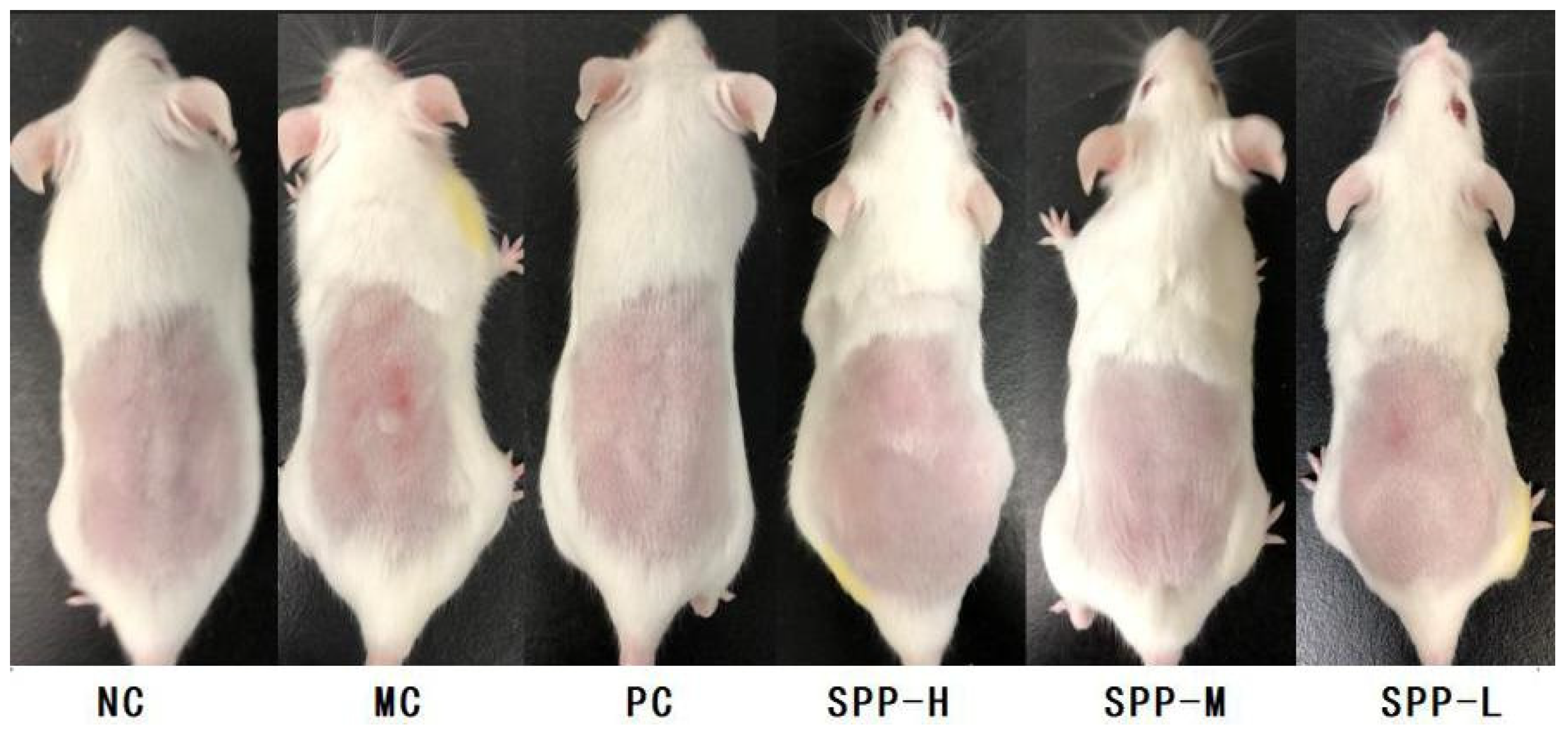
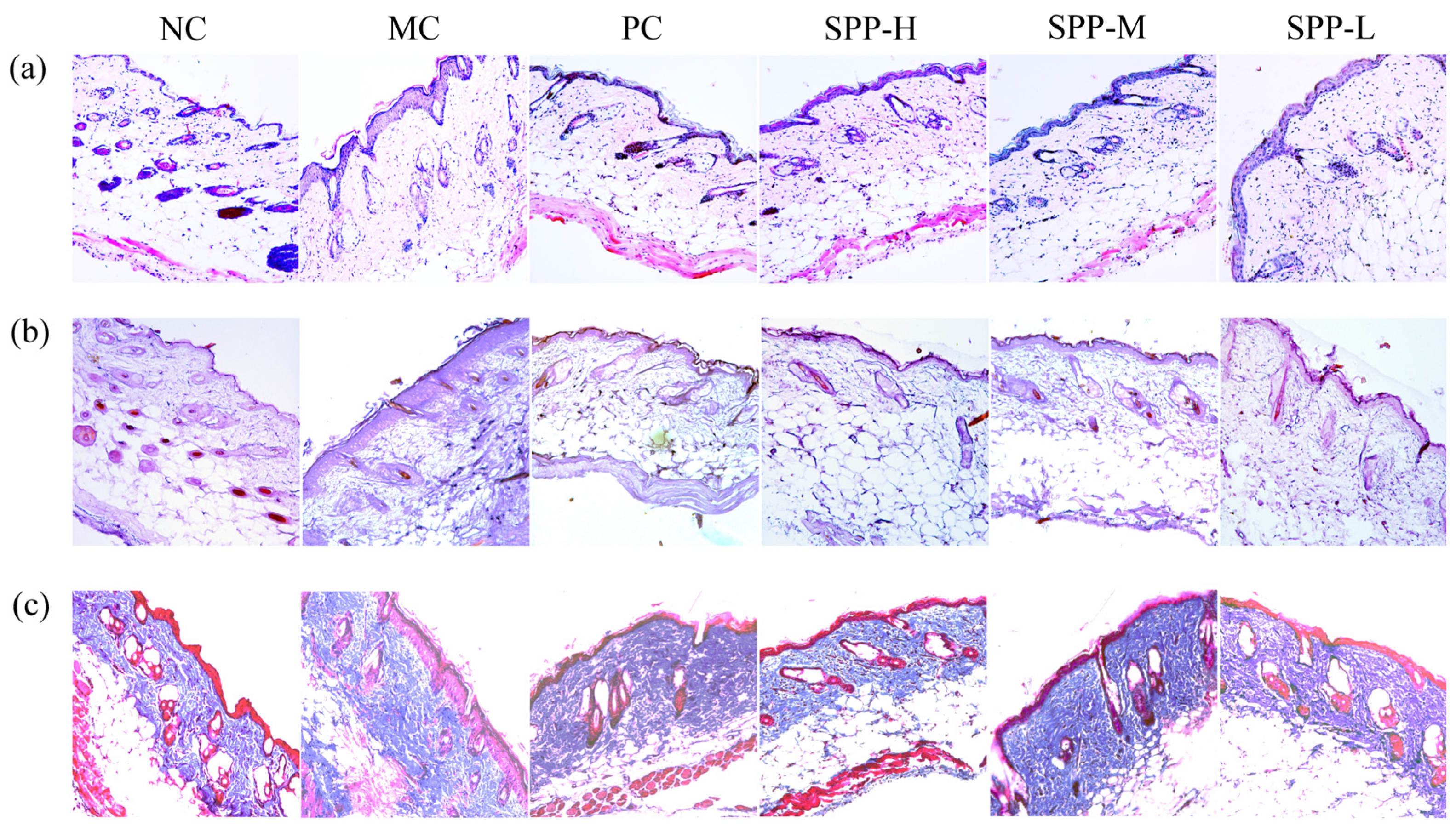
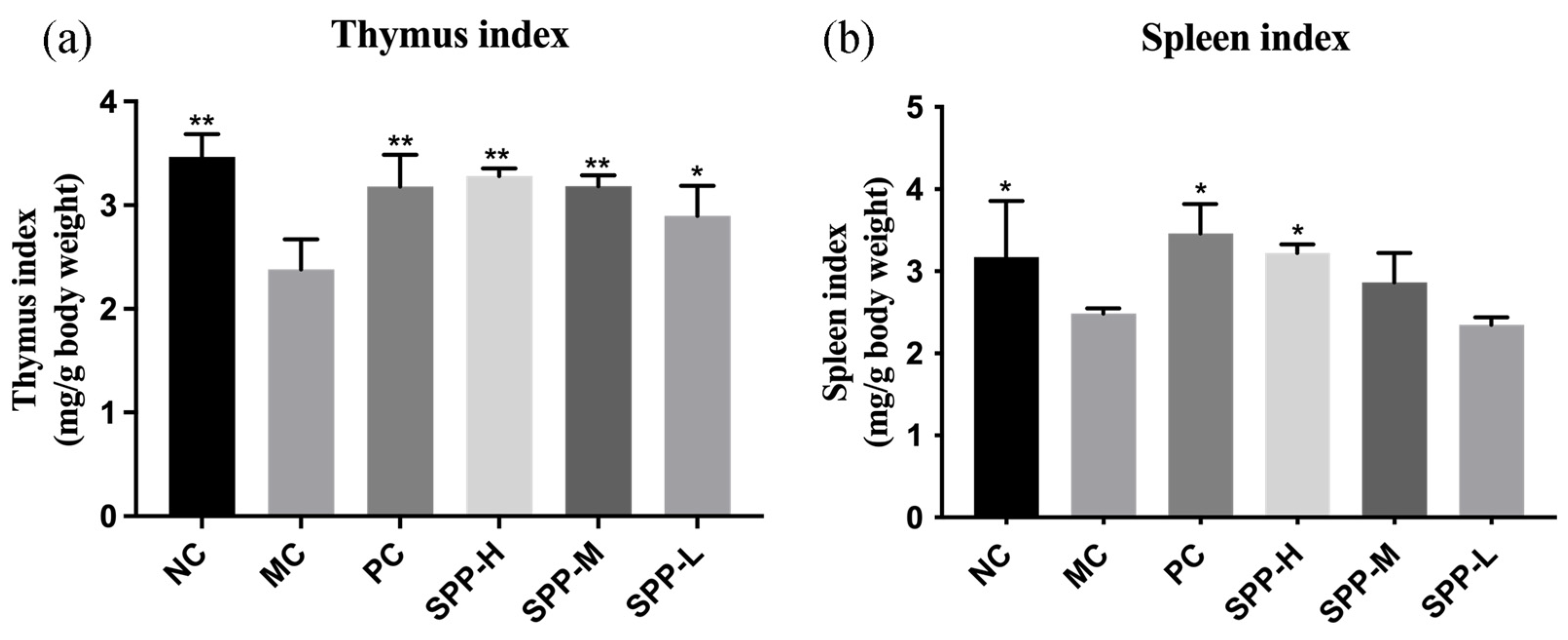
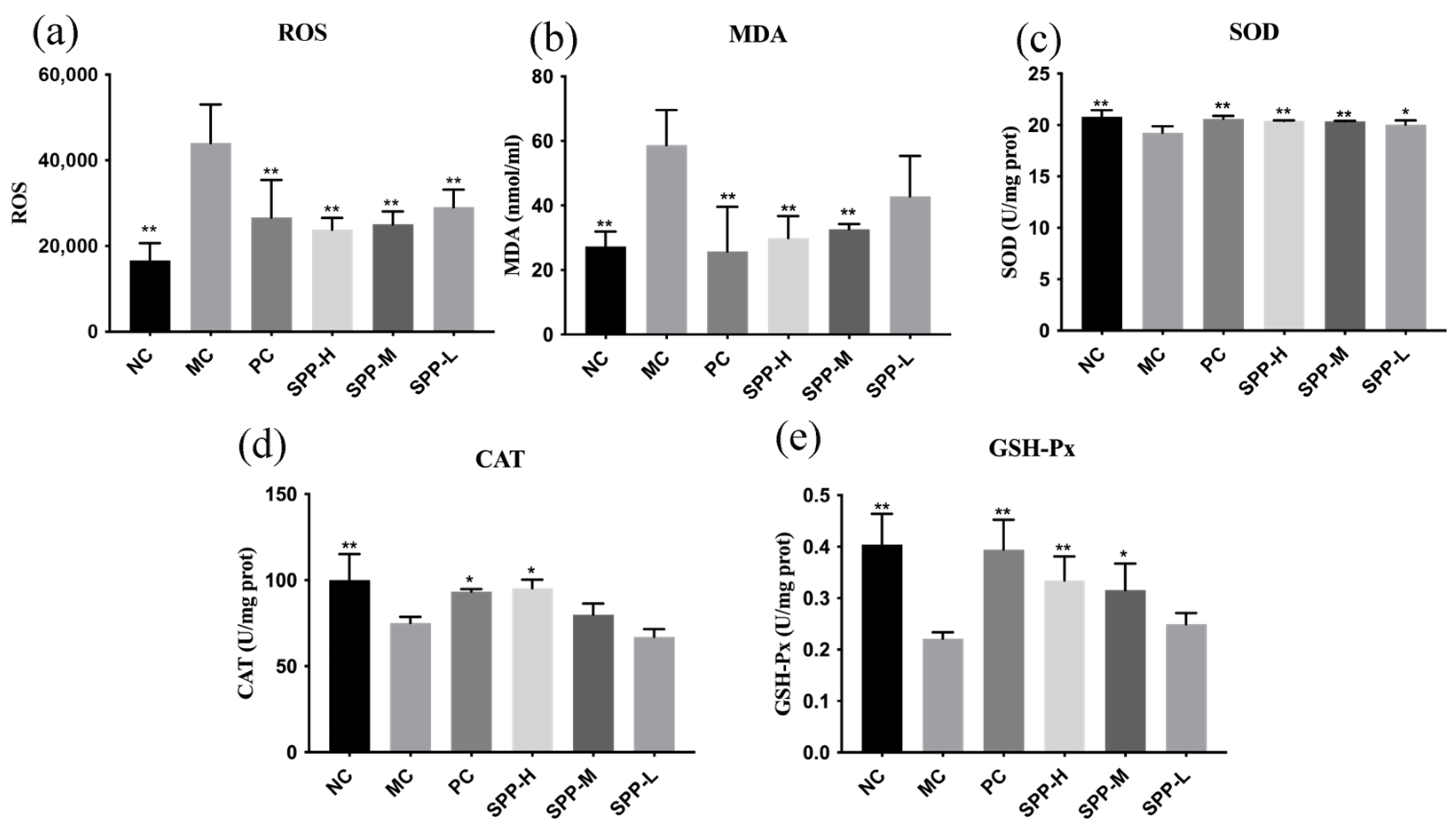
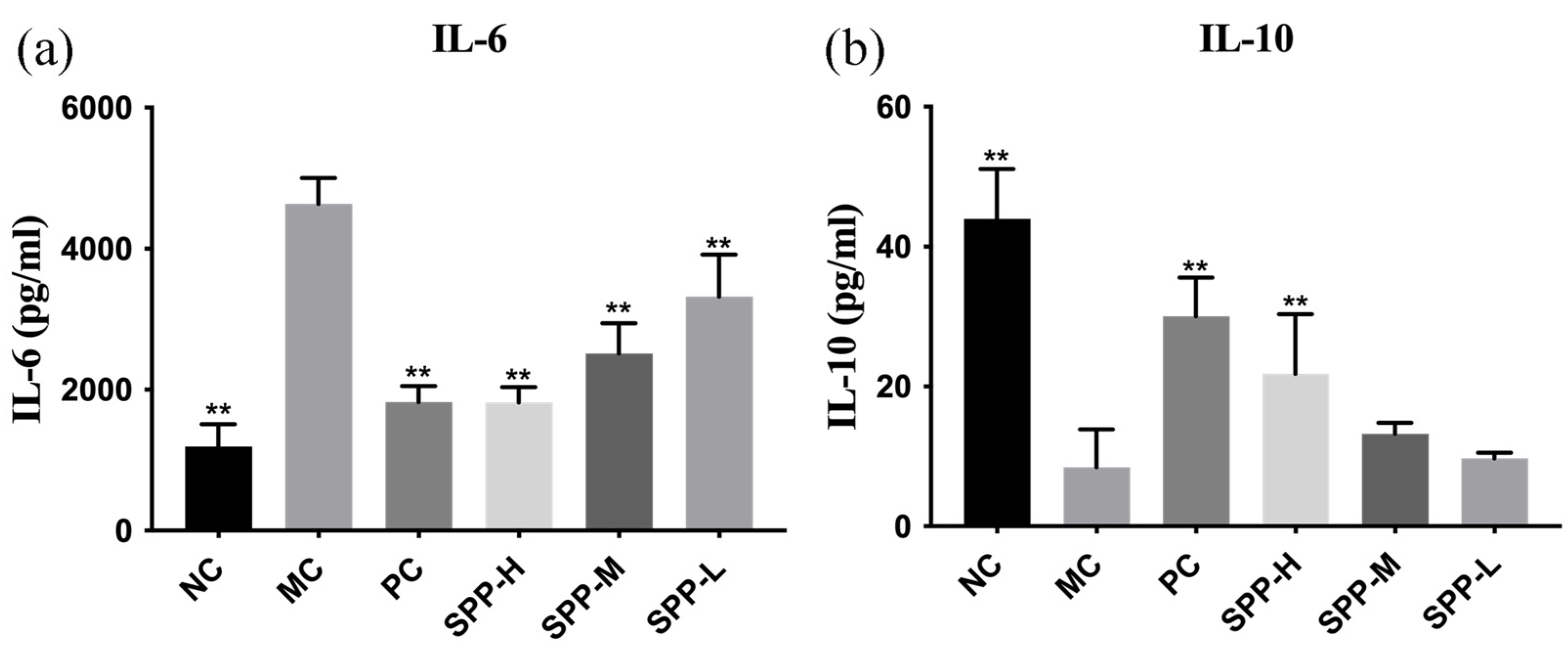
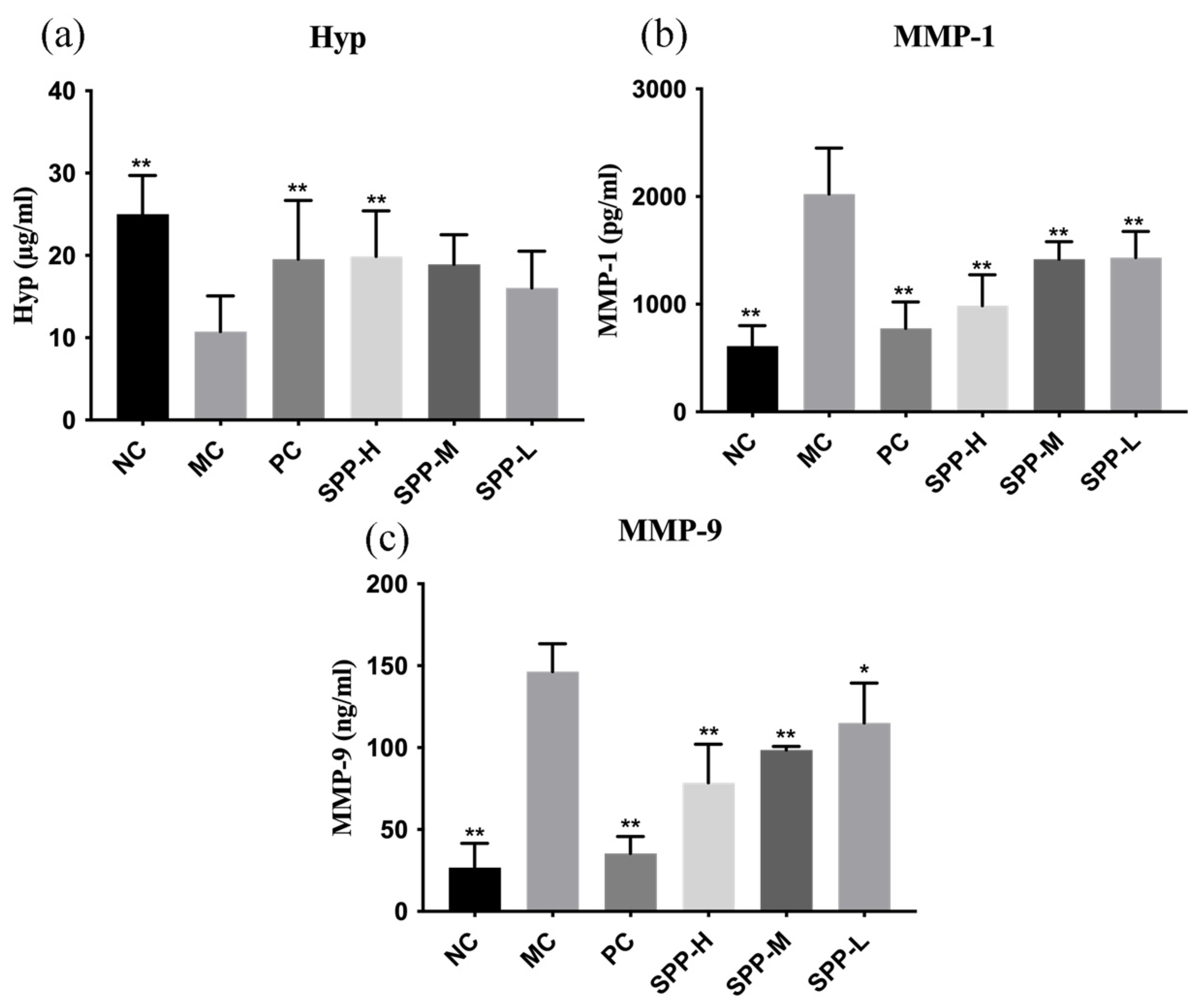
| Level | Parameters | |||
|---|---|---|---|---|
| A Temperature (°C) | B pH | C Enzyme Dosage (kU/g) | D Time (h) | |
| −1 | 35 | 5 | 3 | 3 |
| 0 | 55 | 7 | 4 | 4 |
| 1 | 65 | 9 | 5 | 5 |
| Grade | Evaluation Criteria |
|---|---|
| 0 | Smoothness without any wrinkles; fine striations running the length of the body |
| 1 | Fine striations |
| 2 | A few shallow wrinkles; disappearance of all fine striations |
| 3 | Shallow wrinkles across the dorsal skin |
| 4 | Deep and coarse wrinkles with laxity |
| 5 | Increased deep wrinkles |
| 6 | Surface accompanied by severe wrinkles; development of lesions |
| Peptide | Mass | Length | m/z | RT | Area |
|---|---|---|---|---|---|
| LGKVYDY | 856.433 | 7 | 429.2247 | 31.02 | 1,230,000,000 |
| FLEP | 504.2584 | 4 | 505.2655 | 29.69 | 857,000,000 |
| WNEP | 544.2281 | 4 | 545.2354 | 29.96 | 798,000,000 |
| LYGDGDGSF | 929.3766 | 9 | 930.3835 | 39.65 | 700,000,000 |
| FLTPF | 623.3318 | 5 | 624.3387 | 54.52 | 659,000,000 |
| FVTPF | 609.3162 | 5 | 610.3238 | 50.32 | 655,000,000 |
| LPPF | 472.2686 | 4 | 473.2761 | 43.75 | 640,000,000 |
| LGPLLDPANER | 1193.6404 | 11 | 597.828 | 37.28 | 627,000,000 |
| LRLP | 497.3326 | 4 | 249.6733 | 30.05 | 609,000,000 |
| LRLP | 559.3006 | 5 | 560.3079 | 36.29 | 560,000,000 |
| Group | Visual Score | Recovery Time (s) | Skin Thickness (nm) |
|---|---|---|---|
| NC | 0.00 ± 0.00 **** | 2.17 ± 0.20 **** | 0.41 ± 0.02 |
| MC | 5.17 ± 0.69 | 7.05 ± 0.29 | 1.10 ± 0.16 |
| PC | 2.17 ± 0.37 **** | 2.92 ± 0.25 **** | 0.58 ± 0.05 |
| SPP-H | 3.17 ± 0.37 **** | 4.27 ± 0.44 **** | 0.68 ± 0.03 |
| SPP-M | 3.50 ± 0.50 **** | 5.37 ± 0.37 **** | 0.79 ± 0.03 |
| SPP-L | 4.33 ± 0.47 * | 6.52 ± 0.49 | 0.87 ± 0.03 |
Disclaimer/Publisher’s Note: The statements, opinions and data contained in all publications are solely those of the individual author(s) and contributor(s) and not of MDPI and/or the editor(s). MDPI and/or the editor(s) disclaim responsibility for any injury to people or property resulting from any ideas, methods, instructions or products referred to in the content. |
© 2024 by the authors. Licensee MDPI, Basel, Switzerland. This article is an open access article distributed under the terms and conditions of the Creative Commons Attribution (CC BY) license (https://creativecommons.org/licenses/by/4.0/).
Share and Cite
Lin, X.; Fan, Y.; Li, L.; Chen, J.; Huang, S.; Yue, W.; Wu, X. The Protective Effects of Silkworm (Bombyx mori) Pupae Peptides on UV-Induced Skin Photoaging in Mice. Foods 2024, 13, 1971. https://doi.org/10.3390/foods13131971
Lin X, Fan Y, Li L, Chen J, Huang S, Yue W, Wu X. The Protective Effects of Silkworm (Bombyx mori) Pupae Peptides on UV-Induced Skin Photoaging in Mice. Foods. 2024; 13(13):1971. https://doi.org/10.3390/foods13131971
Chicago/Turabian StyleLin, Xiao, Yuting Fan, Liuying Li, Jiamin Chen, Songyuan Huang, Wenqi Yue, and Xuli Wu. 2024. "The Protective Effects of Silkworm (Bombyx mori) Pupae Peptides on UV-Induced Skin Photoaging in Mice" Foods 13, no. 13: 1971. https://doi.org/10.3390/foods13131971
APA StyleLin, X., Fan, Y., Li, L., Chen, J., Huang, S., Yue, W., & Wu, X. (2024). The Protective Effects of Silkworm (Bombyx mori) Pupae Peptides on UV-Induced Skin Photoaging in Mice. Foods, 13(13), 1971. https://doi.org/10.3390/foods13131971





